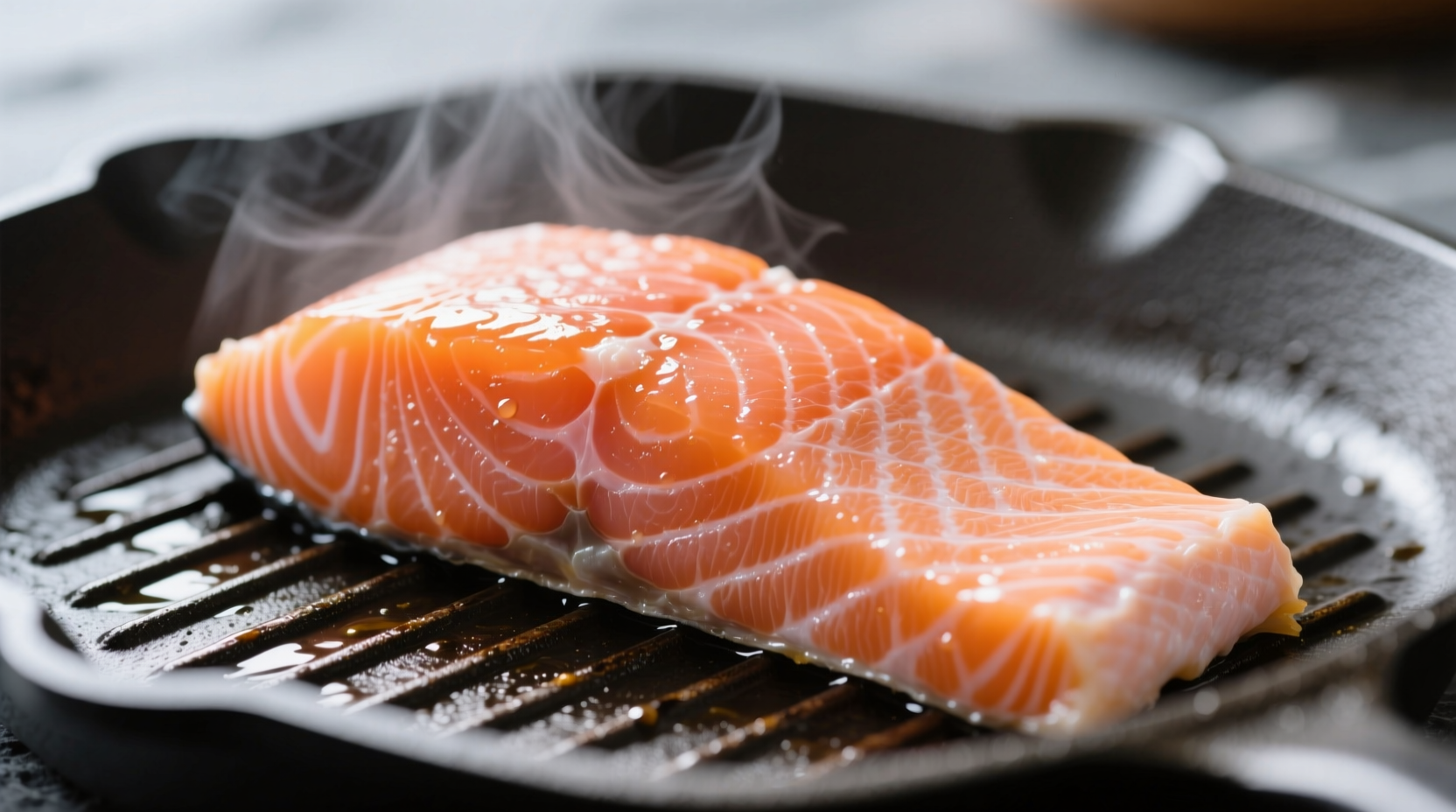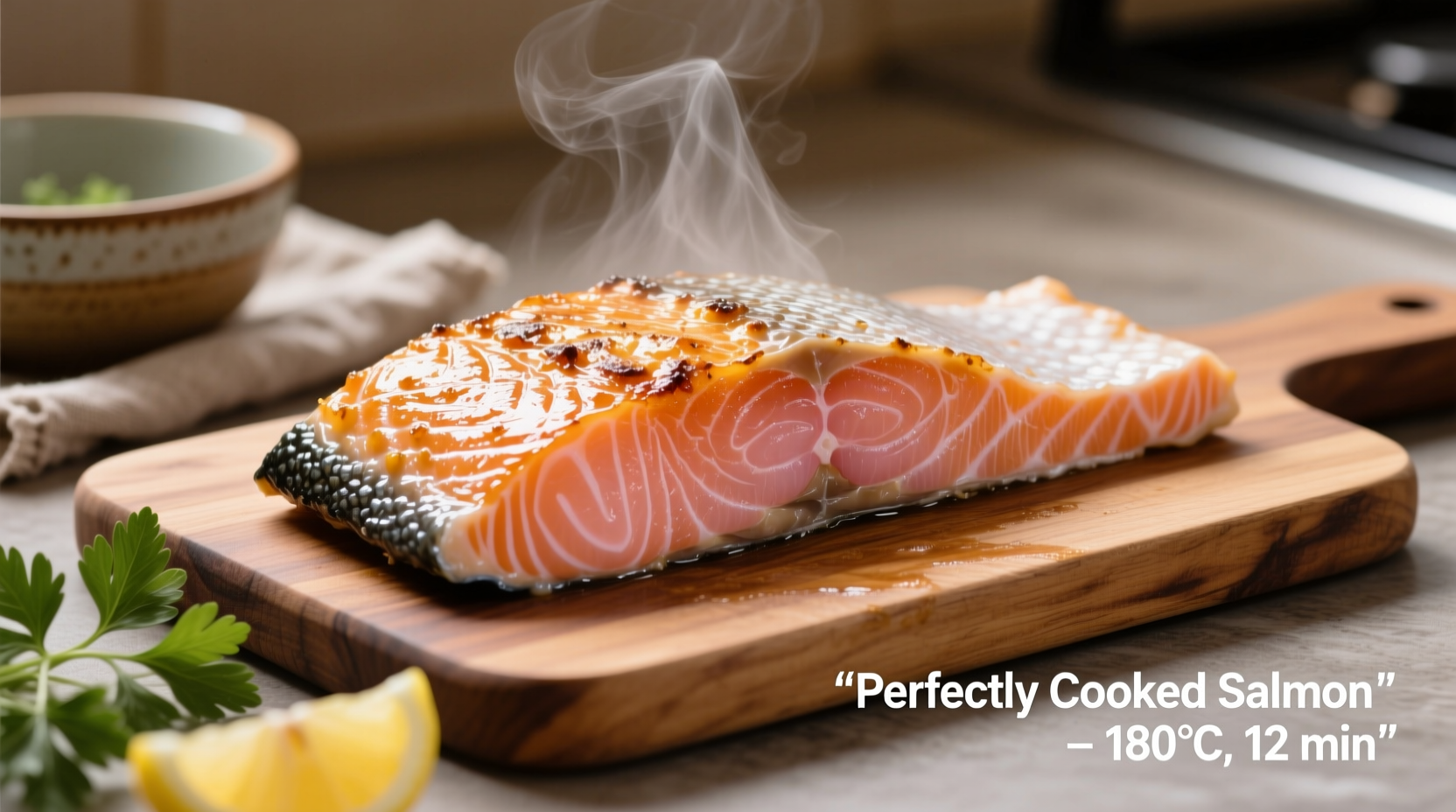How to Visually Identify Perfectly Cooked Salmon
Knowing what cooked salmon looks like is essential for both food safety and culinary success. When salmon reaches the proper doneness, you'll notice distinct visual changes that indicate it's ready to serve. This guide provides clear, science-backed visual indicators to help you consistently achieve perfect results.
Color Transformation: From Raw to Cooked
Raw salmon displays a translucent, deep pink to orange-red color depending on the species and diet. As it cooks, the flesh undergoes a dramatic transformation:
- Initial stage (110°F/43°C): Outer edges turn opaque while center remains translucent
- Medium-rare (125°F/52°C): Most of the flesh becomes opaque with slightly translucent center
- Properly cooked (145°F/63°C): Uniform opaque orange-pink color throughout with no translucency
- Overcooked (160°F/71°C+): Pale, dry appearance with visible white albumin (protein) seeping out
| Cooking Stage | Visual Appearance | Texture | Internal Temperature |
|---|---|---|---|
| Raw | Translucent deep pink | Firm but yielding | Below 40°F (4°C) |
| Medium-rare | Mostly opaque, slightly translucent center | Soft, buttery | 125°F (52°C) |
| Perfectly cooked | Uniform opaque orange-pink | Firm but moist, flakes easily | 145°F (63°C) |
| Overcooked | Pale, dry, white albumin present | Tough, dry, crumbly | 160°F+ (71°C+) |
The Science Behind Salmon's Transformation
Understanding why salmon changes appearance during cooking helps you recognize proper doneness. When heat is applied, salmon's muscle proteins (primarily myosin and actin) undergo denaturation. This scientific process causes the proteins to unravel and then re-bond in a tighter structure, expelling moisture and changing the flesh from translucent to opaque.
According to the U.S. Food and Drug Administration, fish is considered safe to eat when it reaches an internal temperature of 145°F (63°C) or until the flesh is opaque and flakes easily with a fork. This temperature ensures harmful bacteria like Listeria and Vibrio are eliminated while preserving optimal texture and nutritional value.
Texture Test: The Flake Method
The most reliable visual indicator of cooked salmon is the flake test. Gently insert a fork into the thickest part of the fillet at a 90-degree angle and twist slightly. Properly cooked salmon will:
- Flake apart easily along natural muscle lines
- Maintain moist appearance without excessive liquid
- Resist crumbling or becoming dry and stringy
Undercooked salmon won't flake properly and will appear translucent in the center. Overcooked salmon will flake too easily, becoming dry and crumbly with visible separation of muscle fibers.

How Cooking Methods Affect Appearance
Different cooking techniques produce varying visual results, even when salmon reaches the same internal temperature:
- Pan-searing: Creates a golden-brown crust while maintaining vibrant orange-pink interior
- Baking: Produces uniform color throughout with slightly drier surface
- Poaching: Results in more delicate color with minimal surface change
- Grilling: Shows distinct grill marks with slightly darker edges
The USDA Food Safety and Inspection Service emphasizes that regardless of cooking method, the internal temperature should reach 145°F (63°C) for safety. Visual indicators may vary slightly between methods, but the opaque appearance and flake test remain consistent markers of doneness.
Avoiding Common Visual Mistakes
Many home cooks misjudge salmon doneness due to these common visual errors:
- Mistaking albumin for doneness: White protein (albumin) that appears during cooking is normal and doesn't indicate overcooking
- Ignoring carryover cooking: Salmon continues to cook after removal from heat (5-10°F temperature rise)
- Color variations between species: Wild salmon often has deeper color than farmed varieties
- Thickness considerations: Thicker cuts require longer cooking time than thinner portions
Practical Tips for Perfect Results Every Time
Follow these professional techniques to ensure perfectly cooked salmon with ideal appearance:
- Use an instant-read thermometer for accuracy (145°F/63°C)
- Cook to medium-rare (125°F/52°C) if serving immediately, accounting for carryover cooking
- Remove salmon from heat source when it's slightly less done than desired
- Let it rest for 3-5 minutes before serving to allow temperature equalization
- Check for doneness in the thickest part of the fillet
According to culinary research published by the National Institute of Food and Agriculture, properly cooked salmon retains up to 90% of its omega-3 fatty acids, while overcooking can reduce these beneficial nutrients by 20-30%. The visual appearance directly correlates with nutritional preservation.
When Appearance Can Be Deceiving
While visual indicators are helpful, certain factors can make appearance misleading:
- Added colorants: Some farmed salmon receive astaxanthin supplements that intensify color
- Cold-smoked salmon: Appears cooked but remains raw (requires different handling)
- Pre-marinated salmon: Sauce or marinade can alter surface appearance
- Thin fillets: Cook extremely quickly and may appear done before reaching safe temperature
For absolute safety, always verify doneness with a food thermometer, especially when cooking for vulnerable populations like children, elderly individuals, or those with compromised immune systems.
Storage and Leftover Visual Indicators
Properly cooked salmon should be refrigerated within two hours of cooking. When stored correctly (in airtight container at 40°F/4°C or below), it maintains quality for 3-4 days. Signs of spoilage include:
- Dull, grayish appearance instead of vibrant orange-pink
- Excessive moisture or slimy film on surface
- Unpleasant odor (fresh cooked salmon should have mild ocean scent)
- Mold growth (fuzzy spots of various colors)
The USDA Agricultural Research Service confirms that properly stored cooked salmon maintains both safety and quality when these visual indicators remain favorable.
Conclusion: Mastering Salmon Doneness
Recognizing what cooked salmon looks like combines visual assessment, texture testing, and temperature verification. The ideal cooked salmon displays uniform opaque orange-pink color, flakes easily with a fork, and reaches 145°F (63°C) internally. By understanding these visual indicators and their scientific basis, you can consistently prepare salmon that's both safe to eat and perfectly textured.











 浙公网安备
33010002000092号
浙公网安备
33010002000092号 浙B2-20120091-4
浙B2-20120091-4